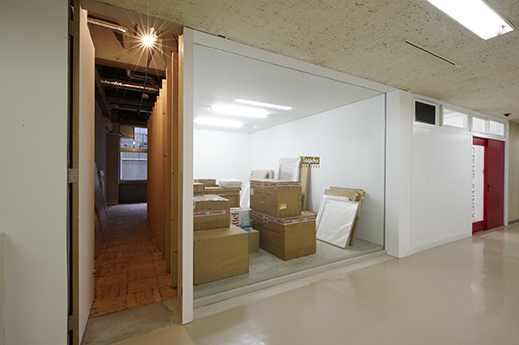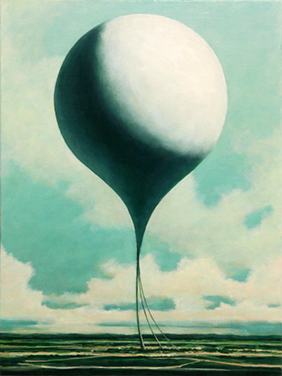 |
|
Here and There introduces art, artists, galleries and museums around Japan that non-Japanese readers and first-time visitors may find of particular interest. The writer claims no art expertise, just a subjective viewpoint acquired over many years' residence in Japan.
|
|
 |
|
|
 |
 |
Music of the Spheres: Minoru Nomata at Sagacho Archives
Alan Gleason |
 |
Minoru Nomata, ascending descending-3 (2018), oil on canvas, 80.5 x 100.3 cm. |
Minoru Nomata is one of a significant roster of artists who made their debut at Sagacho Exhibit Space, a driving force in the creation of Tokyo's contemporary art scene in the 1980s and 1990s. Tokyo artists had long been at the mercy of established Ginza galleries that charged them for the privilege of showing their work, but Sagacho pioneered a new, collaborative artist-gallery relationship in spaces carved out of converted warehouses along the Sumida River. Though the building that housed Sagacho and several other kindred galleries was torn down long ago, its legacy lives on at Sagacho Archives, a venue currently displaying new works by Nomata.
Born in 1955, Nomata worked as a designer for several years before quitting his day job at an ad agency to pursue art full-time. Fascinated by architecture and its appearance as a motif in paintings by such artists as Lyonel Feininger and Charles Sheeler, he began producing pictures of Babel-like towers and other tall structures, all wildly fanciful yet precisely drawn and architecturally sound. Often he anchored his creations on a bucolic landscape that appeared vaguely Mediterranean but without identifiable features, stretching to the horizon under a vast expanse of sky.
Minoru Nomata, Metropolis-7 (2006), acrylic on canvas, 151.5 x 84.0 cm. Collection of Park Hyatt Tokyo |
|
Minoru Nomata, ascending descending-6 (2018), oil on canvas, 117.2 x 0.5 cm. |
Right around the time Nomata made the decision to devote himself to painting, Kazuko Koike, an advertising copywriter with an interest in contemporary art, was beginning to curate shows in Tokyo. She quickly realized, she says, that there was a need for alternative venues that would give young artists an opportunity to present their work without charge. A colleague told her about a large vacant auditorium on the top floor of the Shokuryo Building, a former wholesale rice market that housed the offices of the Association of Koto Ward Food Wholesalers. Built in 1927 on the east bank of the Sumida, this was a sturdy steel-reinforced structure with handsome art-deco furnishings, arched windows and high ceilings. Koike rented the floor and opened it in 1983 as the Sagacho Exhibit Space. As downstairs offices became vacant, they too were snapped up by other enterprising young gallerists. Before long, Sagacho had blossomed into a new art mecca, much like New York's SoHo district a few years earlier.
In 1986 Nomata was looking for a place to hold his first solo exhibition. A mutual acquaintance introduced him to Koike, who visited his studio, saw his paintings and immediately offered him a show. At his Sagacho debut Nomata displayed his entire portfolio to that point -- 42 paintings, most of which he suspended from the ceiling. In its 17 years of existence, Sagacho Exhibit Space held shows for some 400 up-and-coming artists like Nomata, including such present-day luminaries as Yasumasa Morimura, Rei Naito, Shinro Ohtake, and Hiroshi Sugimoto.
Sagacho Exhibit Space, a former auditorium on the top floor of the Shokuryo Building in Sagacho, Tokyo. Photo by Kozo Miyoshi |
The Shokuryo Building, built in 1927. The site is now occupied by a condominium. Photo by Masayuki Hayashi |
Sagacho and its sister galleries thrived at the Shokuryo Building until 2000, when the owners sold the lot to a condo developer. This triggered a diaspora of the galleries that lasted until quite recently as they took up residence in a succession of warehouses on both sides of the Sumida, only to have to move on when those buildings, too, were demolished. Several former Sagacho tenants shared quarters for a time atop the equally legendary Maruhachi Warehouse, eventually moving across town to more upscale digs in Roppongi. Koike, however, chose to put her collection in storage until she could find a new home to her liking. The search took longer than expected, but in 2010 she found the right match: 3331 Arts Chiyoda, a decommissioned middle school that had recently reopened as a community arts center. Since then Sagacho Archives has been presenting exhibitions with a focus on artists who got their start at Sagacho Exhibit Space.
 |
|
Sagacho Archives in storage mode between exhibitions. The window looks out on a hall in the basement of 3331 Arts Chiyoda, which it shares with several other galleries. Photo by Ryota Atarashi |
In the intervening years, Nomata became enamored of hot-air balloons, which he initially depicted with the same draftsmanlike rigor as his buildings. Over time, however, they have evolved into abstract spheres suspended in midair or tethered to the earth by umbilical cord-like strands of indeterminate origin. The surfaces that anchor these archetypal shapes have also grown more ambiguous: sometimes they resemble continental plains, other times the ocean -- or both. Looking closer, one occasionally glimpses what might or might not be a village of red-tile roofs in the middle distance. Always, however, a glorious sky, fair but filled with the grand architecture of cumulus clouds, forms the backdrop. The sun is an unseen but powerful presence, dividing the floating globes into moon-like halves and shadowing the clouds in patterns of light and dark that Nomata obviously delights in composing.
|
 |
|
|
|
Minoru Nomata, ascending descending-10 (2018), oil on canvas, 60.8 x 45.6 cm.
|
Until 27 May, in a show titled ascending descending, Sagacho Archives is exhibiting 14 new works by Nomata, all featuring the same balloon-like motifs. The gallery's intimate space is a surprisingly good fit for these soaring images, which on some subliminal level really do seem to uplift the soul. Nomata attributes much of his inspiration to music, and on 25 May he will hold a "Talk & Music" program with composer and keyboardist Akira Inoue at 3331 Arts Chiyoda (see below for details).
Exhibition view of ascending descending, on display at Sagacho Archives until 27 May 2018. |
In a recent interview Koike spoke enthusiastically of upcoming projects, notably one titled "Up Tokyo," a joint effort by the three downtown Tokyo wards of Chiyoda, Chuo and Taito to showcase the arts in the run-up to the 2020 Olympics. Also in the works are a book and a museum exhibition about Sagacho Exhibit Space and the seminal role played by the Shokuryo Building galleries in placing Tokyo firmly on the contemporary art map.
Today that legacy is vigorously carried on at 3331 Arts Chiyoda. Rented from Chiyoda Ward by a private nonprofit headed by long-time community arts activist and Tokyo University of the Arts professor Masato Nakamura, the converted school is a hive of year-round artistic activity. Situated strategically close to the old Ginza galleries, the museums of Ueno Park, and the Akihabara electronics district, it's an ideal hub for launching art-related projects amid the pre-Olympic hoopla.
Picnicking in the park in front of 3331 Arts Chiyoda, a renovated three-story school building with basement and rooftop garden. Photo by Alan Gleason |
All images courtesy of Sagacho Archives except where otherwise indicated. |
 |
| Minoru Nomata: ascending descending |
| 7 March - 27 May 2018 |
| Sagacho Archives |
| Room B110, 3331 Arts Chiyoda |
6-11-14 Soto-Kanda, Chiyoda-ku, Tokyo
Open 1 to 7 p.m. Friday, Saturday, Sunday, and public holidays
Closed Monday - Thursday
Transportation: 1-minute walk from Suehirocho Station on the Tokyo Metro Ginza Line or 3-minute walk from Yushima Station on the Tokyo Metro Chiyoda Line |
|
 |
| Talk & Music: Akira Inoue (Musician, Composer) + Minoru Nomata (Artist) |
25 May 2018 (Friday)
19:30-21:00 (Doors open at 19:00) |
3331 Arts Chiyoda Lounge (rear left on the first floor)
Capacity 40 (reserved only) |
Admission Fee 2,500 yen (including 1 drink)
* For reservations, please send an e-mail to info@sagacho.jp with your name, the number of participants, and your e-mail address, specifying "5/25 event" on the subject line. Confirmation will be sent back to you within a couple of days. |
|
|
|
| |
 |
Alan Gleason
Alan Gleason is a translator, editor and writer based in Tokyo, where he has lived for over 30 years. In addition to writing about the Japanese art scene he has edited and translated works on Japanese theater (from kabuki to the avant-garde) and music (both traditional and contemporary). |
|
|
|
|
|
|
|
|
|
 |
|